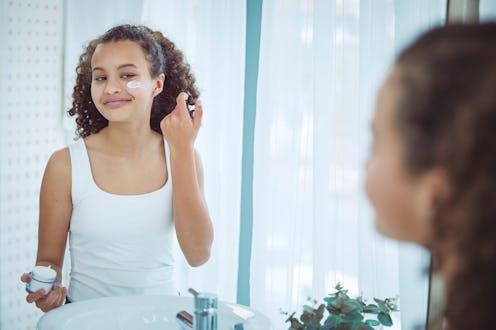
We're constantly being bombarded with things we need to protect our skin from — the sun, the cold winter air, the dirt on our pillows. But there's one thing that may be messing with your pores that you may not have thought of: pollution. So, should you be using anti-pollution skincare products?
According to a recent report by the World Health Organization, air pollution is viewed as the largest environmental health risk factor and people are starting to recognize its harmful effects on skin. Pollution can come from all sorts of things — road and air traffic, fossil fuel combustion, forest fires — and in big cities like New York City over 80 percent of the people are exposed to levels of air pollution which exceed the limits set by the WHO. Yikes.
"These pollutants are easily absorbed through the skin in tiny particles and act to stimulate melanocytes creating pigmented spots," says Dr. Mara Weinstein of Schweiger Dermatology Group. "They also generate reactive oxygen species (ROS), which are free radicals that contribute to oxidative stress. This is damaging to the skin and can accelerate skin aging leading to premature wrinkles." O3 can mess with the skin's surface and deplete it of antioxidant vitamins C and E, so it's necessary to replace the lost vitamins with products to prevent free radical formation, which causes aging. "The most concerning effect is their ability to damage DNA and cause cell mutation which can lead to skin cancer," says Dr. Weinstein.
So, yeah — you should be worried about protecting your skin from air pollutants, and using the right products is key. Here are Dr. Weinstein's tips for making sure your skin stays healthy.
1. Know The Signs
When it comes to pollution damage, your skin may be trying to tell you something. New onset of acne, rosacea or brown spots in previously clear skin after moving to a highly populated area can all be concerning signs. "In other words, your skin was clear when you lived by the beach and now in the city its freaking out!" says Dr. Weinstein. "If this is ever the case, check in with your Dermatologist first before trying to self treat — we should always rule out internal causes like hormones or illness before blaming pollution."
2. Cleanse Well
My Girl Cleanser, $30, Skin Phonic
"Cleansing your skin at least once daily is crucial to prevent buildup of soot from pollution, make-up and all the dust that has accumulated over the day," says Dr. Weinstein. Cleanse with a gentle cleanser — like this one from Skinphonic, which was formulated specifically for anti-pollution use — or, if you're using something harsh or an exfoliant, limit to once a week.
2. Use Toner
Golden Root Multi-Action Anti-Pollution Mist, $27, Amazon
Dr. Weinstein suggests swiping on a toner after you cleanse to lift off any left over debris.
3. Lather On Antioxidant Serum
Skinceuticals C E Ferulic Serum, $145, Amazon
"Follow with an antioxidants help to neutralize free radicals and prevent further damage," says Dr. Weinstein. Since the pollution in the air can mess with your skins natural antioxidants, it's important to add them back in in the form of a serum.
5. Moisturize With Sunscreen
Clarins UV PLUS Anti-Pollution Sunscreen Tint SPF 50, $42, Amazon
Moisturizer adds an layer of protection from the elements to your skin, and using one with sunscreen kills two birds with one stone. "New to the market are the tinted versions which don’t go on leaving your skin looking white and ghostly," says Dr. Weinstein. "The tint provides a little coverage as an added benefit."
6. Try A Mask
LEADERS Advanced Bio-Cellulose Amazonian Acaí Anti-Pollution Mask, $9, Amazon
As with seemingly every skin issue these days, there's a mask out there to help protect your skin from pollution. This one from LEADERS has antioxidants in the form of vitamins B, C and E that will help neutralize and purify your skin.
7. Try An All-in-One Routine
My Girl 3-piece Kit, $60, Skin Phonic
If five steps are too much to keep track of, try this three step cleanser/serum/moisturizer routine from Skinhponic that is specially formulated to combat pollution damage.
Images: Getty Images (2); Courtesy of brands